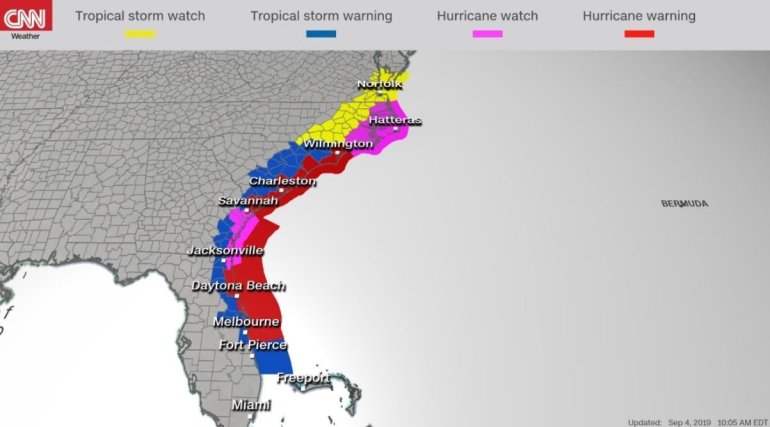
Hurricane Dorian is lashing the Florida coast with rain, surge and tropical-storm-force winds and is expected to march northeast toward a potentially dangerous brush with the Carolinas.
The Category 2 storm, with maximum sustained winds of 105 mph, is churning Wednesday morning about 95 miles east-northeast of Dayton Beach. The storm is expected to turn northeast along the US coastline, teeing up what could be devastating flooding Thursday in Charleston, South Carolina.
The core of the hurricane could be “very near, or possibly over, the coast of South and North Carolina on Thursday and Friday,” the hurricane center said.
Dorian’s close proximity to the coast and the fact that its eye is 50 miles wide means that the storm’s eye wall — with wind gusts of 100 mph — could pass over land, particularly as Dorian heads north, CNN meteorologist Chad Myers said.
“If this storm is 30 miles offshore, that means the Carolina coast does, in fact, get the eye wall,” he said Wednesday morning. “It may not get the center of the eye, but who cares? The center of the eye is calm. It is the eye wall that is the most important part. And as it turns on up toward the north … even if it’s offshore, the eye wall could be very much onshore.”
The flooding risk is particularly acute for Charleston. The city is flat, just a few feet above sea level and next to the ocean, and it commonly floods during typical rain storms.
Dorian’s storm surge in Charleston could be higher than 10 feet, which is just 2 feet shy of the record set two decades ago by Hurricane Hugo, CNN meteorologist Dave Hennen said.

Already, about 245,000 residents along South Carolina’s coast have evacuated, South Carolina Emergency Management spokeswoman Kim Mcleod said. Charleston streets were quiet on Wednesday, and most stores and restaurants downtown were boarded up ahead of the storm. Mandatory evacuations went into effect on Monday for 830,000 residents along the coastline.
Other mandatory evacuations or disaster preparations have been underway since at least late Tuesday in eastern coastal counties of Florida, Georgia, South and North Carolina and Virginia.
On its way to the US, the hurricane swept over the Bahamas, devastating entire towns. The death toll is expected to rise sharply, with the storm already called the greatest national crisis in the country’s history.
Life-threatening storm surge in South Carolina
South Carolina Gov. Henry McMaster declared a state of emergency, tweeting Tuesday night there was “no more time for hesitation.”
“If you’re in an evacuation zone you need to evacuate now,” he said.
South Carolina coastal areas will see life-threatening storm surge and dangerous winds, according to the hurricane center, “regardless of the exact track of Dorian’s center.”
Charleston International Airport said on Twitter that it would suspend operations at 3 p.m. ET on Wednesday until Friday morning, “depending on weather conditions.”
The federal government also granted North Carolina Gov. Ray Cooper’s request for a federal disaster declaration ahead of the storm Tuesday.
“North Carolinians have faced tough storms before and we’re taking every precaution to make sure we’re prepared,” Cooper said.
Earlier this week, the governor ordered evacuations for the barrier islands.
States have been preparing
Florida has been preparing for nearly a week for Dorian’s uncertain impact. Eleven Florida coastal counties were under mandatory evacuation orders Tuesday night as the state felt the storm’s impacts.
“These potential impacts, including flooding, structural damage, storm surge and serious beach erosion in our coastal communities cannot be understated,” Gov. Ron DeSantis said.
Power was out Wednesday morning to thousands of households and businesses in Florida, mostly in Brevard, St. Johns and Volusia counties, the state emergency management website said.
In Georgia, Gov. Brian Kemp issued a mandatory evacuation order for six coastal counties.
“We’re looking at a 4 to 7 foot storm surge which is very high, higher than some of the more catastrophic storms that we’ve seen from a water perspective in the past,” Kemp said Tuesday evening.
“We need people to evacuate,” he said. “This is not a storm to mess with.”
Virginia also declared a state of emergency Tuesday, expecting possible flooding, storm surge, damaging winds and prolonged power outages, the Virginia Department of Emergency Management said.
“Current predictions indicate that it may affect parts of Virginia,” Gov. Ralph Northam said. “I am declaring a state of emergency to ensure that localities and communities have the appropriate level of assistance, and to coordinate the Commonwealth’s response to any potential impact from Hurricane Dorian.”





















